JavaScript and TypeScript stand as synergistic technologies, propelling advancements in both backend and frontend development landscapes. When you decide to create a web solution, the choice of programming language is a pivotal decision that significantly influences the development process and the ultimate success of your project.
At an initial glance, TypeScript and JavaScript may appear remarkably alike. Nonetheless, this apparent similarity does not mean they are equal.
This comprehensive guide aims to illuminate the nuances of TypeScript and JavaScript, assisting developers and entrepreneurs in making informed decisions based on the specific needs and complexities of the projects.
Join us as we navigate the intricacies of these languages, exploring when and why each shines and ultimately empowering you to make the right choice for your development endeavors. So, let’s delve into the main concern: “What is TypeScript vs JavaScript, and how do they differ.”
TypeScript vs JavaScript popularity
JavaScript (JS) has held its position as the preferred programming language for software developers over an extended period. Renowned for its role in crafting dynamic web pages and fueling mobile apps, JavaScript has been a cornerstone of the development landscape.
In recent years, TypeScript (TS) has often been seen as a viable alternative to JavaScript. Despite the established dominance of JavaScript, TypeScript has gained huge recognition. TS is a language that comprises all features of JS and, moreover, has additional functionality.
Let’s consider some statistics data.
JavaScript is positioned as the 3rd most popular programming language by the PYPL Index, while TypeScript follows closely at the 8th spot, showcasing the evolving dynamics within the programming language landscape.
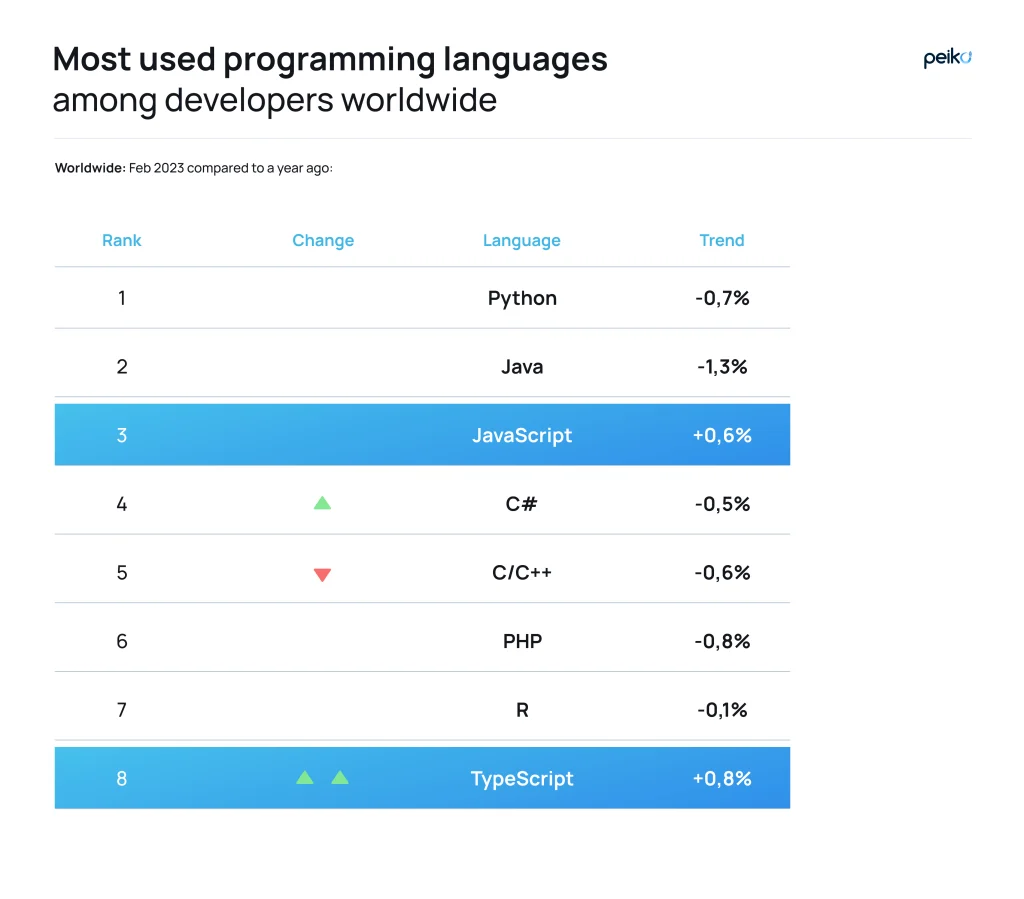
However, these languages are different by their nature. We will look at their main differences further.
JavaScript: definition and history
JavaScript stands as a text-based programming language applicable to both client and server-side operations, contributing to the creation of dynamic and interactive web pages.
By integrating JavaScript, a webpage transforms from static to interactive, elevating the overall user experience. This transition enables websites to move beyond mere informational displays to dynamic platforms that respond to user input and actions.
The incorporation of JavaScript introduces enhanced functionality to websites, fostering a more engaging and responsive online environment.
Some facts about JavaScript
Here are some key milestones in the history of JavaScript since its inception:
- Launched in September 1995 as Mocha, the first scripting language was developed in just 10 days.
- With its growing popularity, JavaScript was submitted to ECMA (European Computer Manufacturers Association) by Netscape in November 1996.
- ECMAScript 3 and ECMAScript 2 were launched in 1998 and 1999, respectively.
- In 2005, Mozilla and Eich collaborated to develop E4X JavaScript.
- The CommonJS project was started in 2009 to drive the language towards ECMAScript 6.
- By 2016, JavaScript was utilized on 92% of all websites on the Internet, including major platforms like Facebook and Google.
TypeScript: definition and history
This programming language doesn’t compete with JavaScript; rather, it is a technology that extends and enhances JavaScript. It was developed by Microsoft in 2012 and is open-source, aligning itself as a superset of JavaScript. This means that all JavaScript code is valid TypeScript code. However, TypeScript vs JavaScript syntax differ.
If we compare TypeScript vs JavaScript syntax, TS syntax includes all the features of JS and provides some additional syntax for type annotations and other language features.
TypeScript aims to address some of the challenges faced by developers by providing a more robust and scalable development experience. This is why we prefer this language for our projects.
Some facts about TypeScript
Here are some significant milestones in the history of TypeScript since its creation:
- TypeScript was publicly released in October 2012 as version 0.8.
- Version 0.9 followed in 2013.
- Microsoft provided support for generics and released TypeScript 1.0 at the Microsoft Build developer conference in 2014.
- In July 2014, the TypeScript development team at Microsoft launched a new TypeScript compiler, boasting a fivefold increase in performance.
- September 2016 saw the release of TypeScript 2.0 by Microsoft, incorporating various additional features, comprising the ability to prevent variables from being assigned null values optionally.
- In March 2018, conditional types were introduced in TypeScript.
TypeScript vs JavaScript differences
JavaScript and TypeScript, despite their shared characteristics, diverge for several reasons:
Type system
- JavaScript: As a dynamically typed language, it determines variable types at runtime, offering coding flexibility for swift development but potentially leading to runtime errors.
- TypeScript: Introducing static typing, TS allows developers to define variable types during compilation. This layer of type checking enhances code reliability and facilitates error detection in the development phase.
Superset relationship
- JavaScript: TypeScript functions as a superset of JavaScript, signifying that all valid JS code remains valid in TypeScript. This establishes a backward compatibility between the two.
- TypeScript: While extending JavaScript with features like static typing and interfaces, TS retains the core syntax and functionalities integral to JavaScript.
Compilation process
- JavaScript: An interpreted language where code is executed directly by browsers or JS engines.
- TypeScript: Requires a compilation step before execution. TS code undergoes transpilation into JavaScript, and the resultant code is what runs in browsers or other JavaScript environments.
Tooling and development environment
- JavaScript: Traditional development in JavaScript relies on text editors and browser developer tools.
- TypeScript: Benefits from advanced tooling support, incorporating features like IntelliSense, enhanced code navigation, and refactoring tools, thereby elevating the overall development experience.
Flexibility vs. structure
- JavaScript: Recognized for its loose and adaptable structure, enabling developers to write code quickly with fewer constraints.
- TypeScript: Introduces a degree of structure through static typing, aiding in early error detection, elevating code maintainability, and supplying additional documentation through type definitions.
Ecosystem and adoption
- JavaScript: Pervasive in web development and universally supported across browsers, establishing itself as a fundamental language for client-side scripting.
- TypeScript: Experiencing a surge in popularity, particularly in sizable projects and enterprise-level applications where the advantages of static typing and enhanced code maintainability are more prominent.
So, while TypeScript builds on JavaScript, but it offers static typing, enhanced tooling, and additional features. This sets TypeScript apart as a distinct language that is more modern and efficient.
Reasons to choose TypeScript vs JavaScript
Embracing TypeScript equips development teams with a robust toolkit and an array of features that include all features of JS and exceed them. These TS’s features actively contribute to elevating code standards, fostering collaboration, and ensuring the overall success of projects:
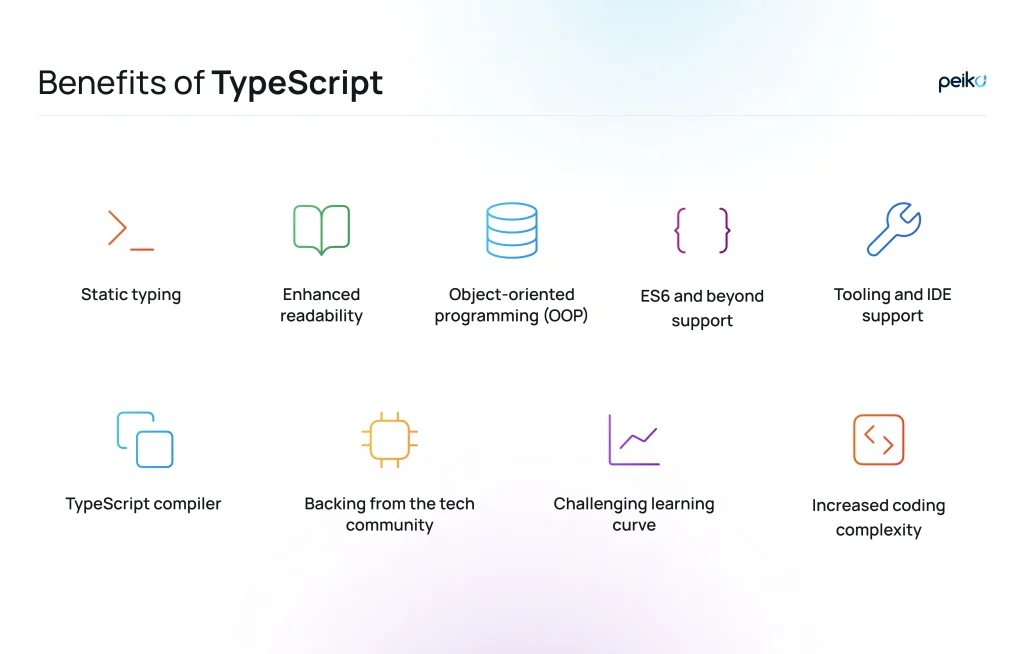
Static typing
One of the distinguishing features of TypeScript vs Vanilla JavaScript (plain JS without additional libraries) is static typing.
The advantage of static typing lies in its proactive approach to error detection. By catching potential type errors before the code runs, developers can address issues at an early stage, significantly improving the overall code quality and reliability. This proactive identification of errors helps prevent unexpected runtime issues that might arise due to type inconsistencies, contributing to a more robust and predictable codebase.
Developers benefit from the clarity and precision that static typing brings to variable declarations. With types explicitly defined, the code becomes more self-documenting, making it easier for both the original developer and collaborators to understand the expected data structures and interactions within the codebase.
Furthermore, the TypeScript compiler’s ability to analyze types enhances the development experience by providing accurate autocompletion suggestions and catching potential issues as developers write code. This results in a more efficient and streamlined coding process, fostering a development environment where code is not only syntactically correct but also resilient and less prone to runtime surprises.
Enhanced readability
TypeScript goes beyond basic syntax and introduces advanced features like interfaces, enums, and more, elevating the overall organization and readability of the code. The inclusion of interfaces is particularly impactful, offering developers a powerful tool to define explicit contracts for the structure of objects. This goes beyond mere documentation, providing a structured blueprint that enhances communication between disparate components within the codebase.
Interfaces act as a set of guidelines outlining the expected shape and behavior of objects. This not only enhances clarity but also serves as a form of self-documentation. Developers interacting with the code can readily understand the expected structure and properties of objects without delving into extensive documentation or inspecting the code itself. This explicit definition of contracts fosters a collaborative and communicative coding environment.
Furthermore, enums (short for enumeration) in TypeScript enable developers to define a set of named constants, making the code more self-explanatory.
Object-oriented programming (OOP)
TypeScript supports OOP principles, including classes, interfaces, inheritance, and encapsulation. This enables developers to structure their code in a more modular and maintainable manner, fostering a cleaner architecture.
Some of the benefits inherent in object-oriented programming include:
Code reusability through inheritance
Leveraging relationships and subclasses among objects facilitates the reuse of common logic while preserving a distinct hierarchy. This feature expedites development, enhancing accuracy through more profound data analysis.
Enhanced flexibility via polymorphism
Objects, depending on the context, can assume multiple forms. The program dynamically identifies the required meaning or usage for each instance of an object, minimizing the need for code duplication and promoting flexibility.
Data security and integrity through encapsulation
Each object’s implementation and state remain privately encapsulated within a defined class or boundary. External objects lack direct access to the class and are restricted from making unauthorized changes. They can only invoke a set of methods or public functions. This encapsulation fosters data hiding, elevating program security and mitigating the risk of unintentional data corruption.
Effective problem solving
Object-oriented programming excels in breaking down complex problems into manageable components. Developers can address each smaller problem by crafting a class that fulfils specific needs, contributing to a more systematic and efficient problem-solving approach.
ES6 and beyond support
TypeScript supports ECMAScript 6 (ES6). It is a standard, providing specifications of how JS should operate. TS also supports later features of JS. This all allows developers to take advantage of the recent JavaScript improvements.
The inclusion of ES6 and later features unlock a treasure trove of capabilities for developers. Notable enhancements encompass diverse features. For example, arrow functions enable more concise and expressive syntax for defining functions. Destructuring, another key feature, allows developers to extract values from objects or arrays with greater simplicity, enhancing code clarity and conciseness. Modules, a fundamental addition to ES6, facilitate better organization and encapsulation of code, leading to a more modular and maintainable codebase.
This support for the latest JavaScript features translates into a modern and efficient development experience within the TypeScript ecosystem. Developers can confidently adopt and implement cutting-edge language features without compromising the integrity of their projects. This adaptability ensures that TypeScript remains a forward-looking and empowering tool for developers seeking to stay at the forefront of JavaScript innovation.
Tooling and IDE support
TypeScript integrates seamlessly with various development tools and provides excellent support in popular integrated development environments (IDEs) such as Visual Studio Code. This ensures a smooth development workflow with features like code navigation, autocompletion, and refactoring.
Here are some of the popular TS code editor tools and IDEs:
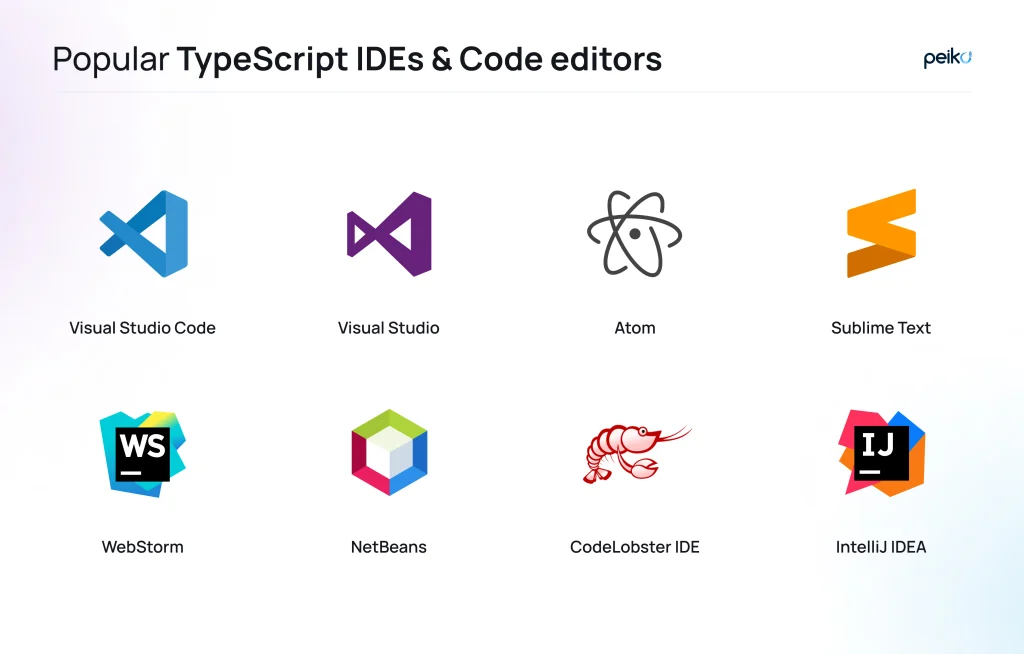
TypeScript compiler
The TypeScript compiler transpiles TS code into standard JavaScript, making it compatible with all major browsers and environments.
This compatibility ensures that developers can enjoy the enhanced features, strong typing, and modern syntax offered by TypeScript without sacrificing the ability to deploy their applications widely. The TypeScript compiler acts as a bridge, allowing developers to work within the TypeScript language for its numerous benefits and then seamlessly translate that code into JavaScript, which can be executed across a broad spectrum of platforms.
Backing from the tech community
TypeScript stands as an open-source language with a community that continues to expand steadily.
At its core, TypeScript is not just a programming language. It represents a thriving open-source ecosystem supported by a steadily growing community. This community expansion is a testament to the widespread acclaim TypeScript has received from millions of developers worldwide.
The endorsement by Microsoft instills confidence in the longevity and continuous improvement of TypeScript. Developers can rely on the fact that TypeScript is not merely a passing trend but a robust and well-supported technology that is likely to evolve with the ever-changing software development landscape.
A notable testament to TypeScript’s efficacy is its adoption by prominent software products such as Asana and Slack. These industry leaders have chosen TypeScript as a foundation to effectively manage and sustain their extensive codebases. This choice underscores not only the reliability of TypeScript but also its scalability and adaptability to handle the complexities of large-scale software development.
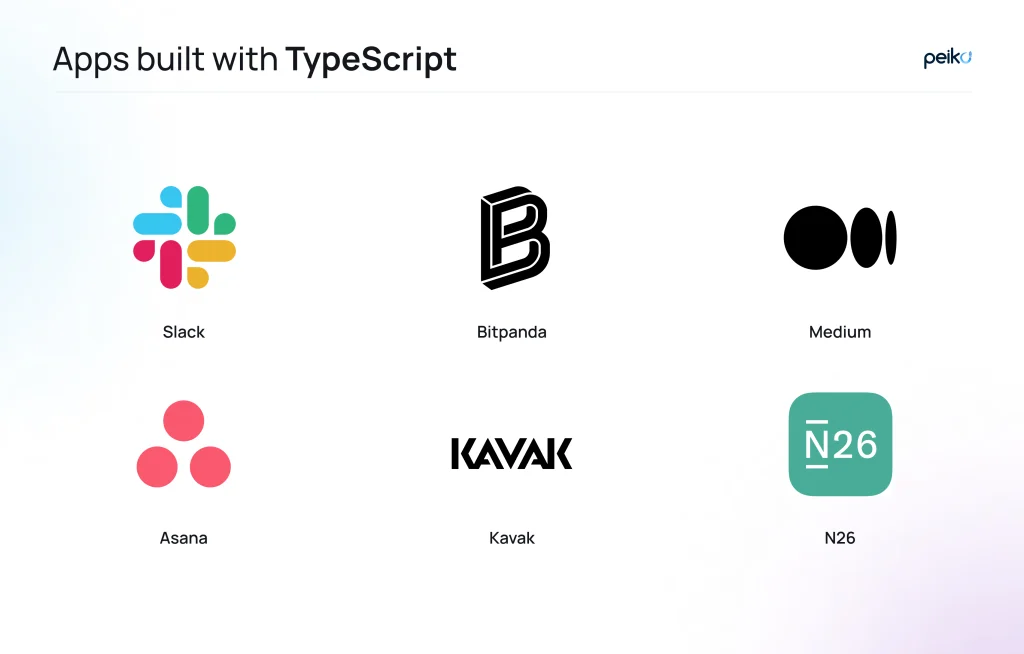
Besides pros, there are some aspects where TypeScript may present challenges. Let’s consider them:
Challenging learning curve
TypeScript entails a more intricate learning process compared to JavaScript. Developers need to grasp the intricacies of static typing and object-oriented programming concepts before efficiently utilizing TypeScript.
Increased coding complexity
Introducing type safety to the codebase in TypeScript can provide an additional layer of complexity to applications, requiring developers to navigate and manage the intricacies of a typed system.
However, these disadvantages are easily offset by the advantages of using TS.
Utilization of TypeScript vs JavaScript
It is better to choose TypeScript for obtaining the following results we mentioned below:
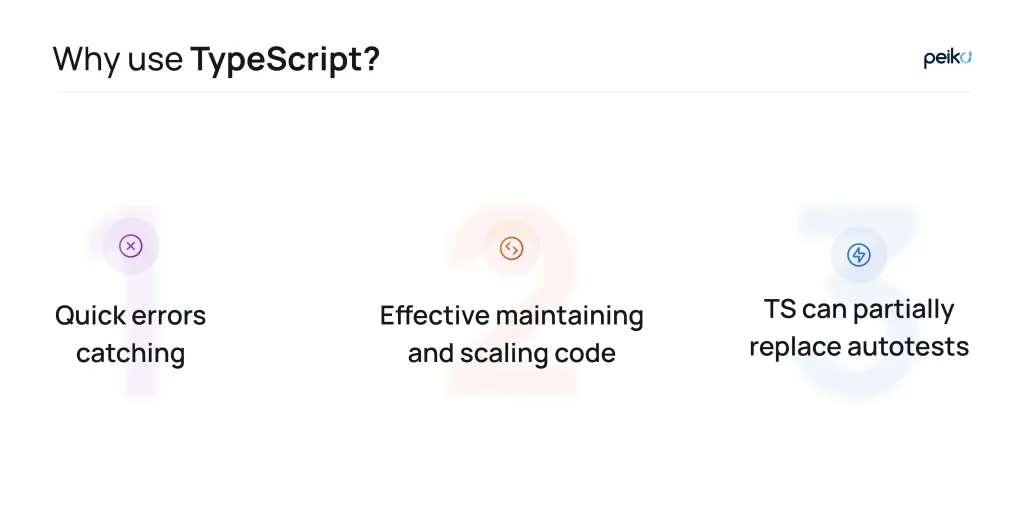
1. Quick errors catching
TS is a great choice for reducing time at the debugging stage and testing the application. By catching errors early in the development cycle, TypeScript contributes to more efficient testing. Developers can have greater confidence in the reliability of their code, leading to reduced testing time and more effective test coverage.
2. Effective maintaining and scaling code
As projects grow in size and complexity, the benefits of TypeScript become increasingly pronounced, reducing the time spent on deciphering and navigating intricate code structures during maintenance.
Developers can confidently make changes, refactor sections, or introduce new features, knowing that the compiler will catch potential issues related to type inconsistencies. This confidence significantly reduces the time traditionally spent on thorough manual testing after each modification, leading to more agile and efficient development cycles.
3. TS can partially replace autotests
In less complex projects, TypeScript’s static types serve a dual purpose by acting as both documentation and a form of validation. The explicit declaration of types provides insights into the expected data structures and interfaces, essentially documenting the code. This documentation aspect, combined with TypeScript’s inherent type checking, can, to a certain extent, replace some autotests for straightforward functionalities.
Peiko’s expertise in choosing the best language for projects
Peiko’s expertise in providing professional custom software development services extends to choosing the best tech stack, with a particular emphasis on ReactJS, VueJS, plus TypeScript. Our skilled team, comprised of seasoned professionals such as business analysts, senior mobile and web developers, creative designers, experienced DevOps specialists, project managers, and QA engineers, ensures that your web applications are built on a robust and efficient foundation.
The tech stack of our blockchain development company empowers us to create dynamic and interactive web solutions, from user-friendly interfaces to complex backend functionalities.
One of the projects we successfully developed – is Quan2um app. This solution stands out as a cryptocurrency exchange facilitating the buying and selling of Bitcoin, Bitcoin Additional, and various altcoins. Recognizing the prevalent preference for smartphones among users, we made the decision to craft a mobile application.
This cryptocurrency exchange development ensures swift and user-friendly interactions. The solution empowers users to engage in trading activities and stay informed about market dynamics from any location.

Thanks to our strategic selection of a robust technology stack, we have succeeded with our blockchain development services. So, the Quan2tum solution stands out for its reliability, speed, and efficiency. The careful consideration of each component in our tech stack has played a pivotal role in ensuring the seamless functionality and convenience of the solution.
Another example of a top crypto exchange solution developed by Peiko is Vorpal. Check our portfolio to discover even more shining blockchain projects.
When it comes to React development, the choice between React TypeScript vs JavaScript was obvious. It involves considering factors like type safety, scalability, and development efficiency. For our projects, in the dilemma of React TypeScript vs JavaScript, we prefer to use TypeScript.
By the way, we will also help you choose between Node.js vs Django and decide on other technologies for your unique blockchain project. Our deliberate approach to technology selection reflects our commitment to delivering cutting-edge products that comply with the highest reliability and user satisfaction standards.
Conclusion: make a smart choice
In this article, we have answered the main question: “What is TypeScript vs JavaScript, and how do these technologies impact web development.” You have found that these programming languages are not the same.
Drawing a direct comparison between these two languages poses a challenge, given that TypeScript essentially extends JavaScript by incorporating additional features.
Consequently, knowing the answer: “What is TypeScript vs JavaScript.” purely in terms of feature count, TypeScript emerges as the clear choice. It preserves the inherent flexibility of JavaScript while introducing a degree of structure, facilitating developers in crafting applications that are both scalable and easily maintainable.
If you are a bold entrepreneur seeking to create a resilient and efficient web solution, contact us. Our expertise will help determine the optimal tech stack for your project, bringing your visionary ideas to life.
No comments yet. Be the first to comment!








